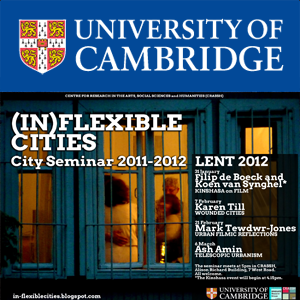City Seminar - 20 May 2014 - Living the Security City: Navigating Karachi’s Enclaves
Duration: 34 mins 54 secs
Share this media item:
Embed this media item:
Embed this media item:
About this item

| Description: |
Sobia A. Kaker (London School of Economics/Newcastle University)
Followed by Cities at Cambridge: Post-Graduate Networking Mixer Abstract In an environment of increased urban insecurity, ‘a new military urbanism’ (Graham, 2010) dictates the logic of urban form. In global cities such as Karachi too, there an obsession with attaining total security—especially around financial centers, ports, residential areas and embassy districts. As a result, passage-point architectures most familiar to airports are transcribed on everyday urban landscapes. The emerging enclaves are created in response to heightened perceptions of vulnerability within a city wrecked by frequent bouts of unexpected violence. But it is important to look beyond the already familiar physical architectures of enclaved cities per se. By focusing merely on the physical architectures of securitized cities—their fortified walls, checkpoints, and barriers—risks an environmentally deterministic perspective. It suggests that these constructions work completely or that their effects can be assumed from their appearance. Complex interconnections between gated enclaves and the rest of the city are easily overlooked. This is especially so when it becomes clear that immense and ongoing labor is required to even create the pretense that relations between the inside of enclaves and the broader city can ever be fully scrutinized and filtered within huge, dynamic, and highly mobile megacities. This presentation draws on empirical references from Karachi, a dynamic Pakistani megacity of 20 million residents. It will centre on the dynamic relationships between those who perform and work the boundaries of enclaves and those who live and use enclaved spaces. Through this perspective it will highlight everyday circulations--an otherwise neglected aspect of urban enclaves—as a productive force. By addressing the neglected question of how the transformation of megacity landscapes into uneven patchworks of securitized enclaves works to produce novel experiences and forms of urban political life, this presentation answers important questions: How is the new security city, the archipelago of gated enclaves, lived and experienced? And with what consequences? |
|---|
| Created: | 2014-06-03 09:16 |
|---|---|
| Collection: | City Seminar |
| Publisher: | University of Cambridge |
| Copyright: | Glenn Jobson |
| Language: | eng (English) |
| Distribution: |
World
|
| Keywords: | CRASSH; City Seminar; |
| Explicit content: | No |
| Abstract: | Sobia A. Kaker (London School of Economics/Newcastle University)
Followed by Cities at Cambridge: Post-Graduate Networking Mixer Abstract In an environment of increased urban insecurity, ‘a new military urbanism’ (Graham, 2010) dictates the logic of urban form. In global cities such as Karachi too, there an obsession with attaining total security—especially around financial centers, ports, residential areas and embassy districts. As a result, passage-point architectures most familiar to airports are transcribed on everyday urban landscapes. The emerging enclaves are created in response to heightened perceptions of vulnerability within a city wrecked by frequent bouts of unexpected violence. But it is important to look beyond the already familiar physical architectures of enclaved cities per se. By focusing merely on the physical architectures of securitized cities—their fortified walls, checkpoints, and barriers—risks an environmentally deterministic perspective. It suggests that these constructions work completely or that their effects can be assumed from their appearance. Complex interconnections between gated enclaves and the rest of the city are easily overlooked. This is especially so when it becomes clear that immense and ongoing labor is required to even create the pretense that relations between the inside of enclaves and the broader city can ever be fully scrutinized and filtered within huge, dynamic, and highly mobile megacities. This presentation draws on empirical references from Karachi, a dynamic Pakistani megacity of 20 million residents. It will centre on the dynamic relationships between those who perform and work the boundaries of enclaves and those who live and use enclaved spaces. Through this perspective it will highlight everyday circulations--an otherwise neglected aspect of urban enclaves—as a productive force. By addressing the neglected question of how the transformation of megacity landscapes into uneven patchworks of securitized enclaves works to produce novel experiences and forms of urban political life, this presentation answers important questions: How is the new security city, the archipelago of gated enclaves, lived and experienced? And with what consequences? |
|---|---|

